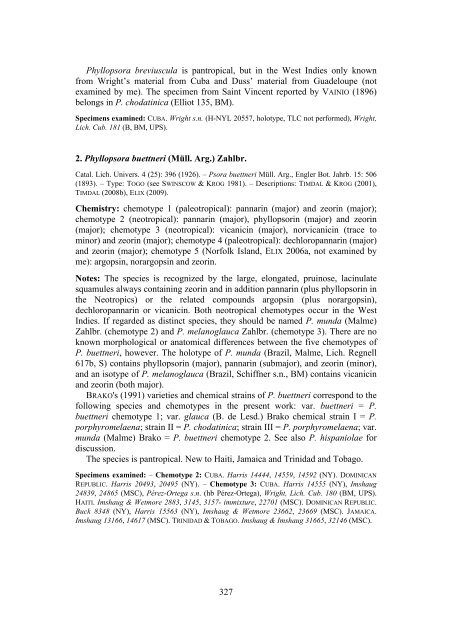A Lichenological Legacy – Festschrift Thomas H
A Lichenological Legacy – Festschrift Thomas H
A Lichenological Legacy – Festschrift Thomas H
You also want an ePaper? Increase the reach of your titles
YUMPU automatically turns print PDFs into web optimized ePapers that Google loves.
Phyllopsora breviuscula is pantropical, but in the West Indies only known<br />
from Wright’s material from Cuba and Duss’ material from Guadeloupe (not<br />
examined by me). The specimen from Saint Vincent reported by VAINIO (1896)<br />
belongs in P. chodatinica (Elliot 135, BM).<br />
Specimens examined: CUBA. Wright s.n. (H-NYL 20557, holotype, TLC not performed), Wright,<br />
Lich. Cub. 181 (B, BM, UPS).<br />
2. Phyllopsora buettneri (Müll. Arg.) Zahlbr.<br />
Catal. Lich. Univers. 4 (25): 396 (1926). <strong>–</strong> Psora buettneri Müll. Arg., Engler Bot. Jahrb. 15: 506<br />
(1893). <strong>–</strong> Type: TOGO (see SWINSCOW & KROG 1981). <strong>–</strong> Descriptions: TIMDAL & KROG (2001),<br />
TIMDAL (2008b), ELIX (2009).<br />
Chemistry: chemotype 1 (paleotropical): pannarin (major) and zeorin (major);<br />
chemotype 2 (neotropical): pannarin (major), phyllopsorin (major) and zeorin<br />
(major); chemotype 3 (neotropical): vicanicin (major), norvicanicin (trace to<br />
minor) and zeorin (major); chemotype 4 (paleotropical): dechloropannarin (major)<br />
and zeorin (major); chemotype 5 (Norfolk Island, ELIX 2006a, not examined by<br />
me): argopsin, norargopsin and zeorin.<br />
Notes: The species is recognized by the large, elongated, pruinose, lacinulate<br />
squamules always containing zeorin and in addition pannarin (plus phyllopsorin in<br />
the Neotropics) or the related compounds argopsin (plus norargopsin),<br />
dechloropannarin or vicanicin. Both neotropical chemotypes occur in the West<br />
Indies. If regarded as distinct species, they should be named P. munda (Malme)<br />
Zahlbr. (chemotype 2) and P. melanoglauca Zahlbr. (chemotype 3). There are no<br />
known morphological or anatomical differences between the five chemotypes of<br />
P. buettneri, however. The holotype of P. munda (Brazil, Malme, Lich. Regnell<br />
617b, S) contains phyllopsorin (major), pannarin (submajor), and zeorin (minor),<br />
and an isotype of P. melanoglauca (Brazil, Schiffner s.n., BM) contains vicanicin<br />
and zeorin (both major).<br />
BRAKO's (1991) varieties and chemical strains of P. buettneri correspond to the<br />
following species and chemotypes in the present work: var. buettneri = P.<br />
buettneri chemotype 1; var. glauca (B. de Lesd.) Brako chemical strain I = P.<br />
porphyromelaena; strain II = P. chodatinica; strain III = P. porphyromelaena; var.<br />
munda (Malme) Brako = P. buettneri chemotype 2. See also P. hispaniolae for<br />
discussion.<br />
The species is pantropical. New to Haiti, Jamaica and Trinidad and Tobago.<br />
Specimens examined: <strong>–</strong> Chemotype 2: CUBA. Harris 14444, 14559, 14592 (NY). DOMINICAN<br />
REPUBLIC. Harris 20493, 20495 (NY). <strong>–</strong> Chemotype 3: CUBA. Harris 14555 (NY), Imshaug<br />
24839, 24865 (MSC), Pérez-Ortega s.n. (hb Pérez-Ortega), Wright, Lich. Cub. 180 (BM, UPS).<br />
HAITI. Imshaug & Wetmore 2883, 3145, 3157- immixture, 22701 (MSC). DOMINICAN REPUBLIC.<br />
Buck 8348 (NY), Harris 15563 (NY), Imshaug & Wetmore 23662, 23669 (MSC). JAMAICA.<br />
Imshaug 13166, 14617 (MSC). TRINIDAD & TOBAGO. Imshaug & Imshaug 31665, 32146 (MSC).<br />
327<br />
eschweizerbart_xxx

















